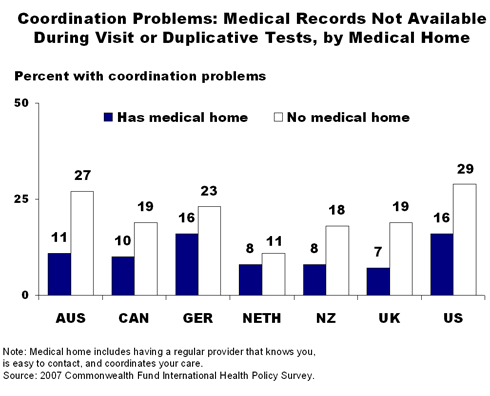A new Commonwealth Fund survey finds that, compared with adults in six other countries, U.S. adults are most likely to go without health care because of the cost and more likely to say that the health care system needs to be rebuilt completely. In addition to cost concerns, the survey analysis, by Fund Senior Vice President Cathy Schoen and colleagues, finds the U.S. has multiple symptoms of less-efficient care.
"Toward Higher-Performance Health Systems: Adults' Health Care Experiences in Seven Countries, 2007" (Health Affairs Web Exclusive, Oct. 31, 2007), highlights the critical role of having a "medical home" that is accessible and coordinates care. In each of the countries surveyed, patients who had such a medical home reported more positive care experiences than those lacking one.
The survey included approximately 12,000 adults in Australia, Canada, Germany, the Netherlands, New Zealand, the United Kingdom, and the United States.
Highest Medical Error Rate in U.S.
Among adults in the seven countries, U.S. adults reported the highest overall error rates, including lab and medication errors. One-third of U.S. patients (32%) with chronic conditions reported a medical, medication, or lab test error in the past two years, compared with 28 percent of patients in Canada, 26 percent in Australia, and fewer patients in the other countries. Patient-reported errors were highest in every country for those seeing multiple doctors or with multiple chronic illnesses.
Skipping Care Because of Costs
In the U.S., 37 percent of all adults surveyed—and 42 percent of those with chronic conditions—skipped medications, did not see a doctor when sick, or did not obtain recommended care in the past year because of the cost. These rates are well above those found in the other six countries. Few people in Canada, the Netherlands, and the U.K. reported skipping care because they could not afford it.
A high proportion of U.S. adults also have serious problems paying medical bills—nearly one-fifth (19%), more than double the rate in the next highest country. Nearly one-third (30%) of U.S. survey respondents spent more than $1,000 in the past year in out-of-pocket medical costs. Nineteen percent of Australians and 12 percent of Canadians spent this much; rates were even lower elsewhere.
Affordability concerns may well be the reason that a third (34%) of U.S. respondents said the health care system needs to be rebuilt completely. This was the highest rate of any of the seven countries.
Access to Care, Care Coordination
All the countries surveyed, except the U.S., have universal health insurance systems. Despite arguments that such systems result in long waits for care, or even rationing, half or more adults in Germany, the Netherlands, and New Zealand reported having rapid access to physicians. Yet in the U.S., only 30 percent of adults said they could get same-day appointments with their doctors when sick. Moreover, two-thirds of U.S. adults—as well as two-thirds of adults in Canada and Australia—reported difficulty getting care on nights, weekends, or holidays.
Adults in the U.S. also reported high rates of coordination problems and billing hassles. For example, 23 percent of U.S. adults said that either test results were not available at the time of an appointment or doctors ordered duplicate tests. Nineteen percent of Germans and 18 percent of Australians reported these problems; rates were lower elsewhere.
Medical Homes Could Improve Performance
Cross-national and U.S.-specific studies find an association between access to comprehensive primary care and both better health outcomes and lower medical costs. In light of such evidence, a movement has emerged to transform primary care practices into "medical homes" that provide an array of patient services in an efficient manner.
To determine if respondents had a medical home, the survey asked if they had a regular doctor or source of primary care; if their provider had information about their medical history; if their provider could be contacted by phone during office hours; and if the provider coordinated their care.
According to these criteria, only about half of adults in all seven countries have medical homes. In each country, patients with medical homes reported more positive care experiences than those who did not, including more time spent with their doctors and greater involvement in care decisions.
In the U.S., the uninsured were at high risk of missing such a connection to the health system: just 26 percent of uninsured adults under age 65 had a medical home, versus 53 percent of the insured.
Those with a medical home were also much less likely to report medical errors, receive conflicting information from different doctors, or encounter coordination problems.
"Achieving better care coordination will likely require designs that include a mix of formally integrated organizations, co-locating or sharing services, and connecting through information systems," the authors conclude. "Developing medical home approaches offers the potential to move toward higher performance."

